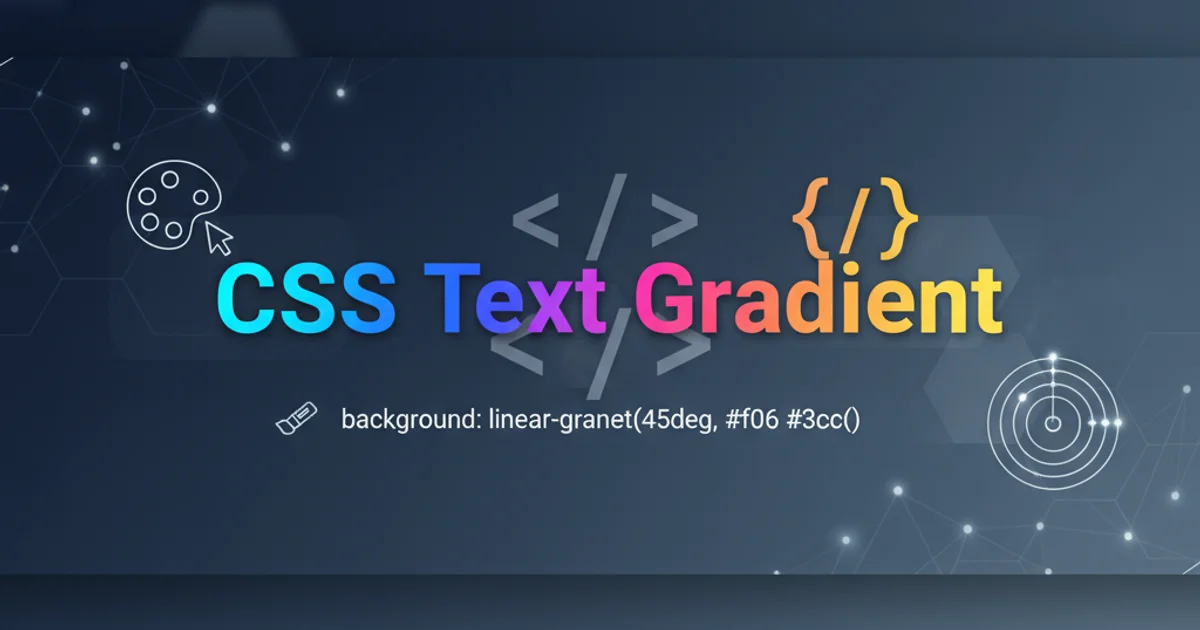css text gradient
Categories:
Creating Stunning CSS Text Gradients

Learn how to apply beautiful gradient effects to text using pure CSS, enhancing your web designs with vibrant and dynamic typography.
CSS text gradients allow developers to apply multi-color transitions directly to text, moving beyond solid colors to create visually rich and engaging typography. This technique leverages CSS properties like background-image with linear-gradient or radial-gradient, combined with background-clip: text and -webkit-text-fill-color: transparent for cross-browser compatibility. Mastering text gradients can significantly elevate the aesthetic appeal of headings, logos, and other prominent text elements on your website.
The Core Technique: Background Clip
The fundamental principle behind CSS text gradients involves applying a gradient as a background to the text element, and then clipping that background so it only appears where the text itself is rendered. This is achieved primarily through the background-clip property set to text. Since background-clip: text is not yet universally supported without prefixes, the -webkit-background-clip: text prefix is crucial for broader browser compatibility, especially with WebKit-based browsers like Chrome and Safari.
.gradient-text {
background-image: linear-gradient(to right, #ff7e5f, #feb47b);
-webkit-background-clip: text;
background-clip: text;
-webkit-text-fill-color: transparent;
color: transparent; /* Fallback for browsers that don't support text-fill-color */
}
Basic CSS for a linear text gradient.
color: transparent; as a fallback. While -webkit-text-fill-color: transparent; is widely supported, color: transparent; ensures that if the gradient fails, the text won't be visible as a solid color, which might be preferable to an unintended solid color.Understanding the Process Flow
To better understand how the CSS properties interact to create the text gradient effect, consider the following process flow. The browser first renders the text, then applies the gradient as a background, and finally clips this background to the shape of the text, making the original text color transparent.
flowchart TD
A[Start: HTML Text Element] --> B{Apply `background-image: gradient(...)`}
B --> C{Apply `-webkit-background-clip: text`}
C --> D{Apply `background-clip: text`}
D --> E{Apply `-webkit-text-fill-color: transparent`}
E --> F{Apply `color: transparent` (Fallback)}
F --> G[End: Gradient Text Rendered]Process flow for rendering CSS text gradients.
Advanced Gradient Techniques
Beyond simple linear gradients, you can explore radial gradients, multiple gradients, and even animated gradients for more dynamic effects. Radial gradients offer a circular or elliptical color transition, while combining multiple gradients can create complex patterns. Animation can be achieved by transitioning the background-position or background-size of the gradient.
.radial-gradient-text {
background-image: radial-gradient(circle at top left, #a18cd1, #fbc2eb);
-webkit-background-clip: text;
background-clip: text;
-webkit-text-fill-color: transparent;
color: transparent;
}
.animated-gradient-text {
background-image: linear-gradient(to right, #ee7752, #e73c7e, #23a6d5, #23d5ab);
background-size: 200% auto;
-webkit-background-clip: text;
background-clip: text;
-webkit-text-fill-color: transparent;
color: transparent;
animation: gradient-shift 3s ease infinite;
}
@keyframes gradient-shift {
0% { background-position: 0% 50%; }
50% { background-position: 100% 50%; }
100% { background-position: 0% 50%; }
}
Examples of radial and animated text gradients.
will-change: background-position; to hint to the browser about upcoming animations, which can help optimize rendering.Accessibility Considerations
While visually appealing, text gradients can sometimes impact readability, especially for users with visual impairments. Ensure sufficient contrast between the gradient colors and the background of the element. Avoid using gradients on small text or large blocks of body text. For critical information, consider providing a solid color fallback or ensuring the gradient maintains high contrast throughout its range.